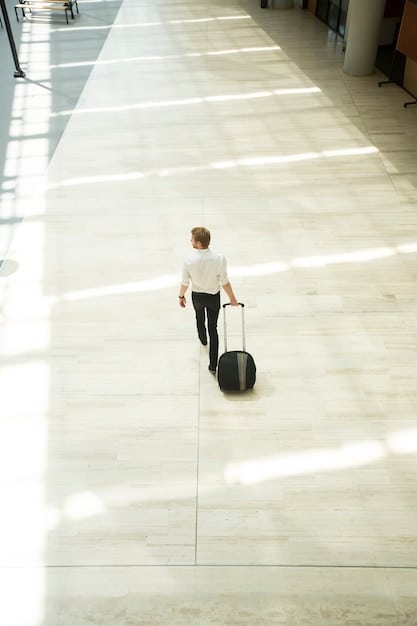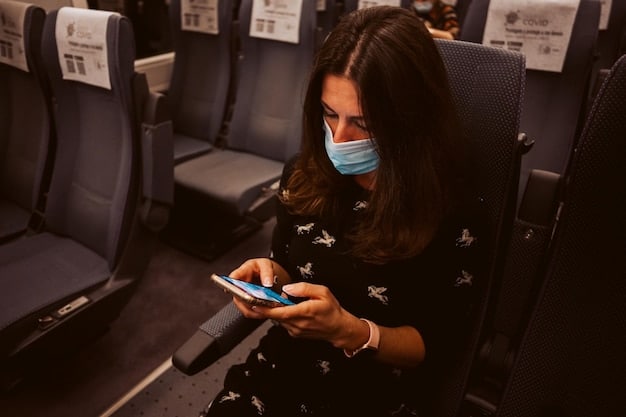Avoid Hidden Fees: 5 Airline Travel Hacks for Smart Travelers

Anúncios
Navigating the complex world of air travel often involves unexpected costs; shrewd travelers can significantly reduce expenses by mastering strategies like understanding baggage policies, leveraging loyalty programs, and opting for flexible booking, effectively employing these five airline travel hacks to avoid hidden fees and experience more economical journeys.
Anúncios
In the evolving landscape of air travel, managing costs has become a fine art. Many travelers find themselves frustrated by the myriad of charges that arise unexpectedly, transforming an initially attractive fare into a significantly larger expense. This article will delve into five essential strategies, or Travel Hacks, airlines hope you remain unaware of, empowering you to avoid hidden fees and ensure your next adventure is both enjoyable and economical.
Mastering the Bag Game: Evading Baggage Fees
Baggage fees represent one of the most common and often infuriating hidden costs in air travel. Airlines have become increasingly sophisticated in their charging structures, making it imperative for travelers to understand the nuances of their luggage. This goes beyond simply knowing your airline’s weight limits; it involves a strategic approach to packing and understanding different bag types.
Many travelers fall into the trap of assuming all carry-on bags are free, only to be hit with a gate check fee when their bag exceeds the strict size or weight restrictions. These fees can sometimes be higher than checked baggage fees, leaving travelers with a sour taste. It’s crucial to check specific airline policies, which often vary significantly, especially across budget carriers.
Anúncios
Understanding Carry-On and Personal Item Distinctions
Airlines typically distinguish between a “carry-on bag” and a “personal item.” The common misconception is that these terms are interchangeable, but they have distinct size requirements. A personal item, such as a backpack, purse, or laptop bag, must generally fit under the seat in front of you. A carry-on, larger in size, usually goes in the overhead bin.
The key here is meticulous measurement. Don’t just eyeball it; use a tape measure on your bags, especially if they are close to the stated limits. Some airlines have sizers at the gate, and if your bag doesn’t fit, you’ll be charged. Being prepared means measuring your bag when it’s fully packed, not just empty.
- Always check the specific carry-on and personal item dimensions for your chosen airline, as they differ.
- Weigh your bags at home using a luggage scale to avoid overweight fees at the airport.
- Consider using a travel backpack designed to fit personal item dimensions, maximizing space without extra cost.
Strategic Packing for Fee Avoidance
The way you pack can be as critical as the bag itself. Maximizing space within allowed dimensions is essential. Techniques like rolling clothes tightly or using packing cubes can significantly compress items, allowing more to fit without exceeding limits. Furthermore, wearing your bulkiest items, like jackets or boots, rather than packing them, can free up considerable space and weight. This might seem minor, but collectively these small adjustments can save you from a hefty fee.
For those planning longer trips, consider the option of shipping some items ahead of time, especially if you’re traveling with specialized gear or a large quantity of gifts. While shipping has its own costs, it might prove more economical than multiple overweight baggage fees, particularly for international flights or airlines known for stringent baggage policies. The calculation involves weighing the shipping cost against potential airline surcharges. When done right, mastering the bag game can lead to substantial savings and a smoother travel experience, giving you more control over your travel budget.
Ultimately, avoiding baggage fees hinges on preparation and vigilance. Never assume; always verify the current policies for each leg of your journey, especially when connecting flights involve different airlines. A little homework before you leave can save you a significant amount of money and unnecessary stress at the airport.
Unlocking Savings: The Power of Loyalty Programs and Credit Cards
Many perceive airline loyalty programs as exclusive clubs for frequent business travelers, but their benefits extend far beyond upgrades and priority boarding. For the savvy leisure traveler, these programs, especially when combined with the right credit cards, can be a potent tool for sidestepping common airline fees and unlocking considerable savings. It’s about strategically accumulating points and understanding how to leverage them for maximum value.
These programs offer various tiers of membership, and even the lowest tiers can often provide significant perks. Think about benefits like free checked bags, priority boarding (which can help secure overhead bin space for your carry-on), or even lounge access, which can save you money on airport food and drinks. The key is consistency; sticking with one or two airline alliances can allow you to accrue points faster and reach beneficial status levels.
Maximizing Points and Perks through Co-Branded Cards
Airline co-branded credit cards are a traveler’s secret weapon. These cards typically offer generous sign-up bonuses in the form of airline miles or points, often enough for a free round-trip flight. Beyond the initial bonus, many provide ongoing benefits directly related to fee avoidance.
- Free first checked bag: This is perhaps the most valuable perk, especially for families, as baggage fees can add up quickly.
- Priority boarding: While not a direct fee avoidance, it secures overhead bin space, preventing gate-check fees for oversized carry-ons.
- Bonus points on airline purchases: Accelerate your earnings specifically on money spent with the airline.
- No foreign transaction fees: Save 2-3% on all international purchases, a hidden cost many travelers overlook.
Before applying, always compare the annual fee against the value of the benefits. For example, if a card offers a free checked bag for you and a companion on every flight, and you travel a few times a year, the savings can easily outweigh the annual fee. Beyond co-branded cards, general travel rewards cards offer flexible points that can be transferred to various airline partners, providing versatility in how you redeem your rewards.
Leveraging Program Benefits Beyond Flights
Loyalty programs aren’t just for booking flights. Many allow members to earn points through hotel stays, car rentals, and even everyday purchases with partner retailers. This broadens the scope for point accumulation, making it easier to reach higher status or accumulate enough points for significant redemptions. For instance, dining at a partner restaurant or shopping online through the airline’s portal can contribute to your points balance.
Understanding the value of your points is also crucial. Sometimes, redeeming points for a direct flight is the best value, but other times, using them for an upgrade or to cover ancillary fees like seat selection might offer a better return. Always calculate the “cents per point” value for different redemption options to make the most informed decision.
Finally, keep an eye on promotions and bonus offers. Airlines frequently run limited-time deals where you can earn extra miles for specific activities or purchases. Subscribing to airline newsletters can keep you informed of these opportunities, ensuring you never miss a chance to boost your balance and unlock more hidden fee savings. By actively engaging with loyalty programs and credit card benefits, travelers can effectively turn potential hidden fees into opportunities for smarter, more economical journeys.
The Art of Seat Selection: Avoiding Fees and Enhancing Comfort
The days of free, blanket seat selection are largely a relic of the past, particularly in economy class. Airlines have become adept at monetizing every possible aspect of the travel experience, and seat choice is a prime example. What was once a simple preference has now often become a premium add-on, with different prices for aisle, window, and especially “extra legroom” or “preferred” seats. However, with a bit of strategy and timely action, you can often secure a desirable seat without incurring additional costs.
Understanding the airline’s seat map and its pricing tiers is the first step. Many airlines use dynamic pricing for seats, meaning the price can fluctuate based on demand, how full the flight is, and how close it is to departure. This presents opportunities for the patient and observant traveler.
Strategic Timing for Free Seat Selection
One of the most effective ways to avoid seat selection fees is to wait. While airlines often nudge you to pay for preferred seats during booking, these same seats may become available for free closer to departure, especially during online check-in (24 hours before your flight). At this point, the airline’s priority shifts from maximizing revenue to ensuring all seats are filled. If premium seats haven’t sold, they are often released to anyone checking in.
The caveat here is the risk. If you wait too long, especially on a full flight, you might be left with less desirable middle seats. This strategy works best if you are flexible with your seat preference or are traveling solo. For families or groups who need to sit together, paying a minimal fee might be a necessary evil to guarantee co-location, though even then, waiting until check-in can sometimes yield adjacent seats if the flight isn’t entirely booked.
- Check your airline’s seat map frequently after booking, observing changes in availability.
- Attempt seat selection during the online check-in window (typically 24 hours before departure).
- Be willing to strategically choose certain seat types; often, rear-of-plane seats are cheaper or free.
Leveraging Technology and Aircraft Knowledge
Several online tools and apps, such as ExpertFlyer or SeatGuru, provide detailed seat maps for virtually every aircraft type flown by major airlines. These resources show you which seats are considered “good” or “bad”—highlighting those with extra legroom, limited recline, proximity to lavatories, or misaligned windows. Checking these before selecting a seat can prevent choosing an uncomfortable spot, whether paid or free.

Moreover, knowing your aircraft type can be a game-changer. For example, some aircraft configurations might have rows with slightly more space due to emergency exits or bulkhead positions. While these are often premium seats, sometimes a less obvious “good” seat can be found that the airline hasn’t classified as premium, or that becomes available at check-in.
If you’re faced with no free options online, consider asking at the gate or during boarding. Gate agents often have more flexibility to assign seats, especially if there are empty rows or more desirable seats that haven’t been claimed. A polite request can often go a long way. Ultimately, navigating seat selection fees requires a blend of patience, strategic timing, and informed decision-making to enhance your travel comfort without breaking the bank.
By understanding when and how airlines open up their seat maps, and by leveraging available tools, travelers can often secure a comfortable spot without succumbing to the pressure of pre-paying for seats. It’s a small but significant victory in the ongoing battle against hidden airline charges.
Bait and Switch: Navigating Travel Insurance and Booking Platform Fees
As you near the final stages of booking a flight online, a common scenario unfolds: a pop-up window or pre-selected checkbox for travel insurance, often accompanied by a discreet booking platform fee. These are classic “bait and switch” tactics, where what seemed like a straightforward purchase suddenly includes additional, often unnecessary, charges. Understanding how to identify and deftly avoid these add-ons is crucial for a truly economical trip.
Travel insurance, while undeniably valuable in certain situations, is frequently offered at an inflated price or with coverage that may not be suitable for your specific needs. Many travelers already have adequate coverage through their credit cards or existing personal insurance policies, making the airline’s offering redundant. Similarly, booking platform fees often appear as small surcharges, but they add up, especially if you book multiple segments or through various sites.
Scrutinizing Travel Insurance Offers
First and foremost, never blindly accept the pre-selected travel insurance option. Always take a moment to deselect it. Then, assess your actual need for travel insurance. Consider the cost of your trip, any non-refundable elements, potential health risks, and the political stability of your destination. If you decide insurance is necessary, compare independent travel insurance providers. Sites like SquareMouth or InsureMyTrip allow you to compare policies from multiple companies, often at a fraction of the price offered by airlines or online travel agencies, and with more tailored coverage options.
- Deselect any pre-selected travel insurance options during the booking process.
- Assess your existing insurance coverage (credit cards, health insurance) before considering new policies.
- If needed, shop independently for travel insurance to compare prices and coverage.
Dodging Booking Platform Fees and “Convenience” Charges
Online travel agencies (OTAs) and even airline websites sometimes tack on “booking fees,” “convenience fees,” or “processing fees.” These are essentially hidden costs for the service of facilitating your reservation. While often small, they are entirely avoidable. The best defense is to always compare prices directly on the airline’s official website versus any OTA you might be using. Often, the airline’s site will offer the same fare without the additional booking fee.
Furthermore, be wary of dynamic pricing models where the price changes as you add different components (like bags or seats) or even as you simply refresh the page. This is less a “fee” and more a pricing strategy, but it can lead to higher costs. Clearing your browser’s cookies or using incognito mode can sometimes help mitigate this, as it prevents the website from tracking your browsing history and potentially adjusting prices based on perceived demand.

Another common trick is the “price guarantee” or “flexibility fee,” which promises you can change your flight without a fee. While this can be beneficial, evaluate if you truly need this flexibility. For many leisure travelers, fixed plans mean this fee is an unnecessary expense. Read the fine print to understand the limitations of such guarantees; they often don’t cover fare differences, only the change fee itself. Vigilance at the booking stage, meticulous review of the final price breakdown, and a willingness to compare across platforms are your best tools against these subtle yet impactful hidden fees.
By consciously opting out of unnecessary add-ons and scrutinizing every line item, you maintain control over your budget. This proactive approach ensures that the “bait” of an attractive initial fare doesn’t lead to an unpleasant “switch” of higher final costs, putting more money back in your pocket for your travels.
Beyond the Ticket: Smart Strategies for Airport Services and Transfers
The journey doesn’t end when you step off the plane; the airport environment itself is a minefield of potential hidden fees, from pricey Wi-Fi and inflated food costs to confusing ground transportation options. Airlines might not directly profit from all of these, but they certainly benefit from an ecosystem where travelers are accustomed to paying for convenience. Smart travelers, however, know how to navigate these challenges, ensuring their savings extend beyond the flight itself and encompass the entire travel day.
Many airports have become commercial hubs, with concessions charging premium prices for basic necessities. A bottle of water, a quick snack, or even a few hours of internet access can quickly deplete a traveler’s budget if not approached strategically. The key is pre-planning and self-reliance, mitigating the need to pay exorbitant airport prices for items you could easily bring yourself.
Minimizing Airport Incidental Costs
One of the easiest ways to avoid unnecessary airport spending is to pack smart. Carry an empty reusable water bottle through security and fill it at water fountains post-security. Pack your own snacks, especially for longer layovers, to avoid overpriced terminal food. If you need to work or connect, check if your airline lounge access (via a credit card or status) includes free Wi-Fi, or if public Wi-Fi is available. Most airports now offer at least a limited period of free Wi-Fi, negating the need for paid services.
Consider the cost of parking at the airport versus alternative transportation methods. Long-term parking can be surprisingly expensive. Research rideshare options, public transport, or pre-booked airport shuttles. Often, leaving your car at home and using an alternative can save a significant amount, not just in parking fees but also in gas and potential wear and tear on your vehicle.
Optimizing Ground Transportation Upon Arrival
Immediately upon arrival, travelers are often faced with myriad transportation choices—taxis, ride-shares, rental cars, or public transport. The most convenient option isn’t always the most economical, and often, taxis capitalize on travelers’ fatigue or unfamiliarity to charge higher rates. Pre-researching local transport options can save you a significant amount.
- Research public transportation options (trains, buses) from the airport to your accommodation; they are often the cheapest.
- Compare rideshare apps (Uber, Lyft) to traditional taxi fares for your destination.
- If renting a car, book in advance and compare prices across different rental companies and pickup locations (sometimes off-airport locations are cheaper).
Moreover, be aware of “airport surcharges” often added to taxi or rideshare fares originating from airport premises. Sometimes, walking a short distance outside the immediate airport zone to catch a ride-share or taxi can bypass these fees entirely. For those staying with friends or family, coordinating pick-ups directly at the curb or a specific meeting point can avoid costly wait times or parking fees for the driver.
For international travel, consider purchasing a local SIM card or an eSIM upon arrival for affordable data, rather than relying on expensive international roaming or limited airport Wi-Fi. This facilitates navigation, communication, and real-time research on local transport, helping you make informed decisions on the go and continue to avoid hidden costs. By extending your cost-saving mindset to airport services and ground transportation, you ensure a smoother, more budget-friendly journey from start to finish.
These seemingly small costs accumulate, turning an otherwise affordable trip into a drain on your finances. A proactive approach to these airport incidentals ensures that your hard-earned savings on airfare are not eroded before you even reach your destination.
| Key Hack | Brief Description |
|---|---|
| 🎒 Baggage Mastery | Understand and adhere to airline baggage policies; weigh and measure bags at home. |
| 💳 Loyalty & Credit | Leverage airline loyalty programs and co-branded credit cards for free bags and perks. |
| 💺 Smart Seat Selection | Delay seat selection until online check-in to potentially get good seats for free. |
| 🛡️ Fee Scrutiny | Deselect unwanted travel insurance and compare prices to avoid booking platform fees. |
Frequently Asked Questions About Avoiding Airline Fees
Airlines implement hidden fees primarily to offer a lower base fare, attracting customers with seemingly cheap tickets. They then generate additional revenue by unbundling services, charging separately for things like baggage, seat selection, and even printing boarding passes, transforming these into ancillary revenue streams that boost profitability.
The most effective ways to avoid baggage fees are by traveling with only a personal item that fits under the seat, or by leveraging airline co-branded credit cards that offer free checked bags as a perk. Additionally, always check your airline’s specific baggage dimensions and weight limits before packing.
Yes, airline loyalty programs can significantly save you money on fees. Higher status tiers often grant benefits like free checked bags, priority boarding (which helps secure overhead bin space), and sometimes even complimentary preferred seat selection. Earning points through flying or co-branded credit cards can unlock these valuable perks.
No, you should not always pay for seat selection during booking. Many airlines release unsold premium or preferred seats for free during online check-in, typically 24 hours before departure. Waiting until this window for seat assignment is a common hack to avoid extra charges, especially if you’re flexible with your seating.
To avoid hidden fees with OTAs, always compare the final price with the airline’s official website. OTAs may add “booking” or “convenience” fees that airlines don’t. Also, carefully review the breakdown of charges before confirming your purchase, and deselect any pre-checked boxes for travel insurance or other add-ons you don’t need.
Conclusion
Navigating the complex world of air travel doesn’t have to be a frustrating experience filled with unexpected costs. By adopting these five travel hacks—mastering baggage rules, leveraging loyalty programs and credit cards, strategically selecting seats, scrutinizing booking platform fees, and optimizing airport services—you empower yourself to bypass many of the hidden charges airlines hope you overlook. A proactive, informed approach transforms potential financial drains into opportunities for smarter, more economical journeys, allowing you to allocate your budget towards your destination rather than unforeseen fees. Embrace these strategies, and embark on your next adventure with confidence and a significantly lighter wallet, due to savings, not expenditures.





